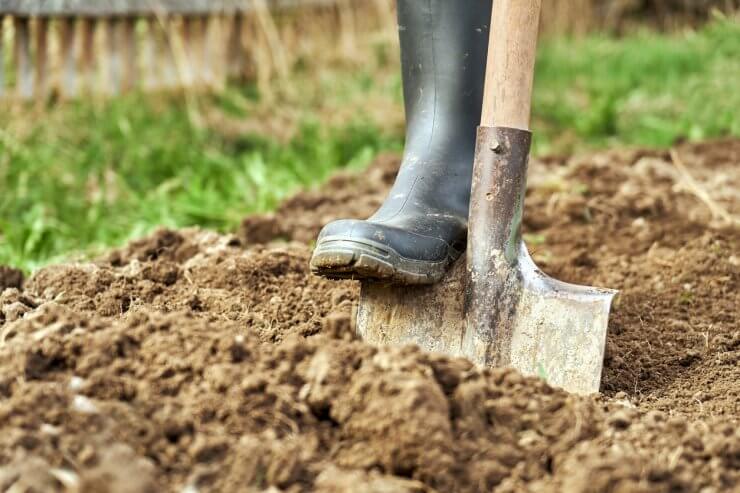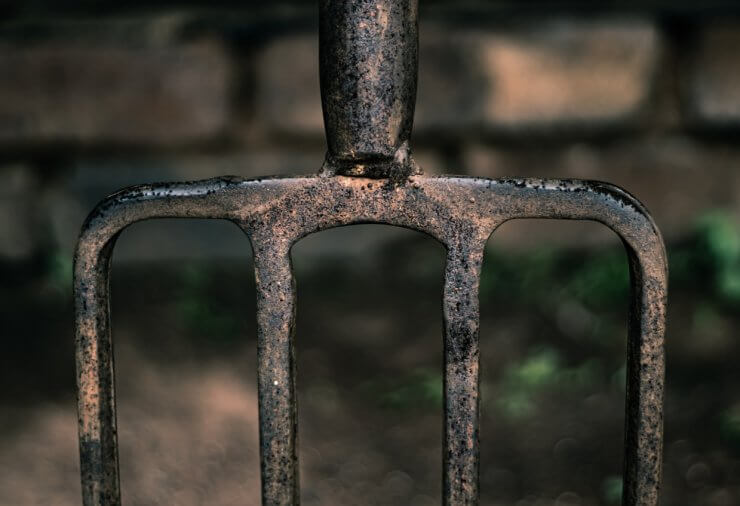
I’ll admit that part of the joy of gardening is having a good excuse to play in the dirt. As adults, we don’t get to do that very much, but it sure does feel good. Of course, playing in the dirt actually means getting the soil ready; there’s always compost to add or weeds to dig up. Even when you have “perfect” soil, you still have to do some prep work. Preparing clay soil for planting your garden isn’t that much different.
Well, that’s not entirely true. There are some differences, but that’s just in the details. Clay soil gets a bad rap. And while it’s true that it can turn to brick under a blazing summer sun, or turn into a boot-stealing suction cup after a heavy rain, clay also has a lot of advantages for gardeners.
Because clay is so dense, it hangs onto the nutrients and moisture that your vegetables need to thrive. But to get those benefits, you have to start by preparing clay soil for planting. I’ll be honest, it will take some time to do it right. But no one ever said gardening was about instant gratification. Although if someone did say that, we’d all know not to take their gardening advice!
Discover 7 top tips for growing, harvesting, and enjoying tomatoes from your home garden—when you access the FREE guide The Best Way to Grow Tomatoes, right now!

7 Tips for success when you’re preparing clay soil for planting your favorite veggies
1. Find out if your soil really is clay. If you can squeeze together a handful of your soil, craft clay figures, and sell them as folk art on Etsy, you probably have clay soil. You can also send a soil sample to your closest lab for soil testing, which isn’t a bad idea anyway, given the amount of toxic materials that could be there.
2. Add organic matter. This will take a bit of forethought on your part, but one way you can start preparing clay soil for planting is to add a couple of inches of organic matter to the soil and work it in with a garden fork or similar garden tool. Grass clippings, straw, or chopped leaves all work well for this, but they will need two to three months to break down and create soil that’s easier for vegetables to grow in.
3. Add compost. If you have compost ready to go, you can move the prep time along quite a bit. As with organic matter, add a two- or three-inch layer of compost to your clay soil and work it in with a garden fork.
4. Plant vegetables that grow well in clay. Even if you add organic matter or compost, you may have more gardening success if you plant vegetables with shallow roots, such as leaf lettuce, beans, or squash.
5. Plant cover crops. If you can wait a season to get going on your garden, one method of preparing clay soil for planting is to plant cover crops to help break up the clay soil. Some gardeners even suggest fava beans as a cover crop, which would give you a truly tasty added benefit. Seriously, fresh fava beans are the bee’s knees.
6. Add mulch. A thick layer of mulch will help keep the clay from baking in the sun, it will help loosen the clay as it breaks down, and it will help prevent the clay from becoming more compact if you step on it.
7. Try a raised bed or container garden. As an alternative to dealing with clay soil, you can also opt for a raised bed or try container gardening. Both offer many advantages, plus you could still use that clay soil for your Etsy folk art business.
Have you had to deal with clay soil in your garden bed? What did you eventually do? I’d love to read your story in the comments.
Discover 7 top tips for growing, harvesting, and enjoying tomatoes from your home garden—when you access the FREE guide The Best Way to Grow Tomatoes, right now!





Insightful
Very helpful article!
Why am I getting Garden Tips 6-9 months after comments and replies?
I nearly forgot the potatoes! I have large tubs with different varieties of potatoes growing as well. This is a new venture and I’m hoping to get some lovely new potatoes in a few weeks. The mint is already waiting to go in the pot with them 🙂
I have to rely on all raised growing containers because I’m too disabled to be able to dig at all except with a little hand fork. I still get beautiful vegetables though. There’s not much that won’t grow in a raised container. At the moment I have tomatoes, rhubarb, strawberries, cauliflower, Brussel sprouts, spring onions, perpetual spinach, salad greens, Bok choy, Chinese cabbage, mint, parsley and rocket all growing well. Lots of it is trial and error to see exactly what will grow in my region in the arid zone of Australia. I have to get help for planting fruit trees, and currently have a Meyer lemon, mandarin and fig all growing well plus a grapevine that is just starting to show the new season’s growth. An orange tree and new passion fruit plants to replace one that is now dying off are in the planning stages. I just love being able to go into my garden with a basket and harvest some fresh salad for lunch or a few veges for dinner, or some fruit to replenish the fruit bowl. If I did have to grow in the garden soil, it would be quite a major undertaking as we have nothing but rock hard solid clay for the majority of the time, or a quagmire of sticky mud for the short time each year when it rains.
I always use this as an excuse to play with dirt actually. And reading through your tips gave me proper knowledge about soil and how to prepare them. I used to just trust that the soil is okay haha. Thanks for this blog!
When we bought our house 45 years ago I had to have a garden. Tiling the soil was almost impossible because of the heavy clay. Each year for 10 years we added 40 bags of compost, then a mix of compost and steer manure. Compost got too expensive so we switched to steer manure only. It’s been a long haul but the soil is brown now instead of red and is easy to work. Everything I plant grows, some years better than others. I still try to add organic matter when ever I plant. I love my garden!
Love this success story, and happy for you and your garden!
Clay soil but I always add top soil and black kow to it and then work it in. I’ve had great success with tomatoes and okra (my two faves). Planted zucchini this year so we’ll see.
Good luck! Have you heard of the no-dig method, where you basically build mounds on top of your soil with compost and manure, instead of digging into the ground? That’s another idea for clay!
Clay in our soil. Lots. Dug it up and made a dish in ceramics room.
THAT is awesome, you could make planters too!